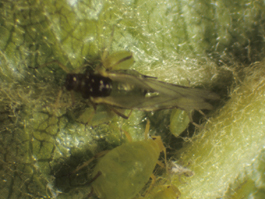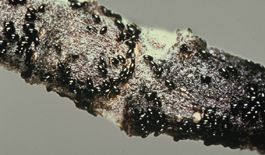by Elizabeth H. Beers, Stanley C. Hoyt, and Michael J. Willett, originally published 1993
(Homoptera: Aphididae)
Apple aphid
Aphis pomi De Geer
Spirea aphid
Aphis spireacola Patch (= Aphis citricola van de Groot)
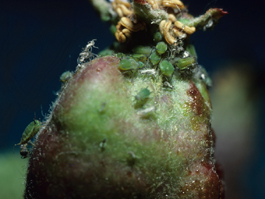
The apple aphid (often called the green apple aphid) is considered to be the most widespread aphid pest of apple around the world. Recently, entomologists have reported that a nearly identical aphid, the spirea aphid, has become more numerous than apple aphid on apple in Virginia, West Virginia and Maryland. The spirea aphid is the dominant aphid species on apple in Israel and China and is found more often than green apple aphid in some Washington State orchards. Because these two aphids are virtually impossible to separate in the field and little research has been conducted on the spirea aphid as a pest of apple, the biology, behavior, economic impact and management of these two species will be treated together in this section.
Hosts
The apple aphid can occasionally colonize pear and hawthorn, but its primary host is apple.
Life stages
Egg
The egg is shiny, black and roughly the shape of a rice grain but only about 1/50 inch (0.5 mm) long. It cannot be distinguished from the egg of two other species, rosy apple aphid and apple grain aphid, that overwinter on apple.
Nymph
The nymph is yellowish green to dark green, about 1/16 inch (1.5 mm) long.
Adult
The wingless adult green apple or spirea aphid is bright green with black cornicles, legs and antennal tips. The winged adult has a black head and thorax with a yellow-green abdomen. Both winged and wingless forms are about 1/8 inch (3 mm) long.
Life history
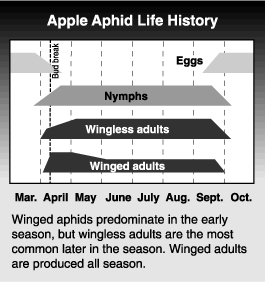 Apple and spirea aphids overwinter as eggs laid on smooth twigs and watersprouts. Egg hatch begins about silver tip stage of bud development and is generally complete about the half-inch green stage. All the young are females, known as “stem mothers,” which produce both winged and wingless female offspring.
Apple and spirea aphids overwinter as eggs laid on smooth twigs and watersprouts. Egg hatch begins about silver tip stage of bud development and is generally complete about the half-inch green stage. All the young are females, known as “stem mothers,” which produce both winged and wingless female offspring.
The winged forms predominate during this generation and although winged forms are produced almost continuously, wingless forms predominate through the rest of the season. The nymphs feed for 10 to 20 days (depending on temperature) before they become adults.
Through most of the season female aphids are produced parthenogenetically (without fertilization) from eggs held internally. Starting in August and throughout the autumn months, they are found almost exclusively on watersprouts or terminals of young trees that are still growing. Both male and female sexual forms are produced at this time of year.
These late season sexual forms mate to produce the overwintering eggs. At least 9 generations have been reported on apple each year and up to 17 in warmer west coast locations. The ability of these insects to produce live young partially accounts for the rapid buildup of aphid populations. Unlike some aphid species, which migrate to an alternate host during the summer, green apple aphid spends its entire life cycle on apple.
Damage
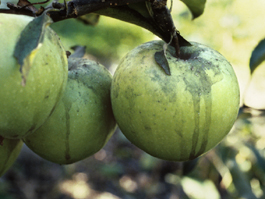
Both nymphs and adults suck phloem from their hosts and prefer to feed on succulent, young tissue. Aphids may be found feeding on the undersides of leaves, on growing shoot tips or the shoot stem. When populations are high, the upper leaf surface will also be colonized. High populations early in the year may also feed directly on developing fruits, causing small bumps and red spots to appear at the feeding sites. Aphids feeding on fruit of Golden Delicious and Granny Smith later in the season can result in small circular red spots. These disappear by harvest.
The most important damage from these aphids is generally caused by the presence of copious amounts of honeydew excreted by the aphids. This honeydew is extremely annoying to harvesting crews. When honeydew drips onto the fruit, it is often colonized by a black, sooty fungus, Fumago vagaus Fries, which causes russeted areas on the fruit, especially around the stem. Although mechanical washing done in commercial packing lines removes most of the sooty mold from the fruit surface, some is left in the stem cavity. The black sooty mold is especially apparent on light colored cultivars like Golden Delicious.
Shoot growth can be stunted on young trees, but in older Red Delicious orchards there is generally no effect on growth, yield or fruit quality. Golden Delicious trees may be more susceptible to shoot growth reduction, but this is unlikely to have economic consequences on a large, mature tree.
Biological control
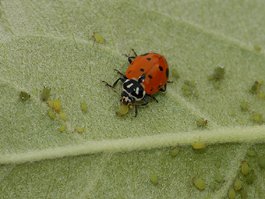
A number of natural enemies attack aphids. The most important predators are lady beetles, syrphid fly larvae, green lacewings and the predatory bug Deraeocoris brevis (see Predators and Parasitoids). Biological control may be disrupted by pesticide applications or weakened by poor synchrony between the development of aphid populations and their predators during June. Two species of parasitic wasps, Lysiphlebus testaceipes (Cresson) and Praon sp., attack apple aphid primarily early in the season, but neither species completes its development on apple aphid, so their potential usefulness in an IPM program may be limited. There appears to be a strong relationship between the availability and effectiveness of the parasites and the presence of other aphid hosts outside the orchard.
More research is required to understand this relationship. Success of the parasites and predators may depend more on seasonal factors, shoot growth patterns and cultural practices that slow aphid population growth rates without limiting the natural enemies. Environmental factors and cultural practices that encourage shoot growth will also create the potential for more severe apple aphid problems.
Monitoring
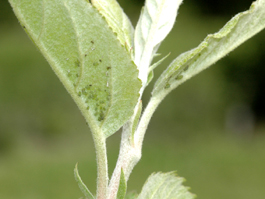
Begin monitoring for apple aphids and spirea aphids in late May to early June when shoot leaves are rapidly expanding. Most sampling schemes recommend sampling growing shoots and/or shoot leaves and are aimed at estimating when aphid infestations will reach a density that will result in honeydew-related fruit russet.
However, many factors can influence the amount of potential damage, including tree structure, tree age, time of year, tree nutritional status and variety. Past recommendations were to sample and treat when 50% of the terminals were infested. This has resulted in overtreatment, and the treatment threshold has since been raised to 75% of the terminals infested.
Recent research in both Washington and Pennsylvania suggests that the number of infested leaves per shoot is a better indicator of potential damage than just percentage infested shoots. In Washington 4 to 5 infested leaves per infested shoot signals a problem, which means that a population resulting in 2 to 3 infested leaves per randomly chosen shoot should be treated.
Pennsylvania research suggests an average of 1 to 3 infested leaves per randomly selected shoot would exceed the treatment threshold. Based on the Pennsylvania research, sampling 20 shoots from each of 5 trees, 10 shoots from each of 7 trees, 5 shoots from each of 10 trees, or 2 shoots from each of 20 trees would all give accurate estimates of aphid densities. The location of the infestation is critical. For example, thresholds would be lower if the infestations are on spur shoots rather than on terminal shoots. Young, non-bearing trees should probably be treated at lower infestation levels to insure proper growth.
Management
Delayed-dormant sprays targeting several insect and mite pests are still the first step in controlling apple aphid populations. Summer control of aphid populations that exceed the treatment threshold is still most quickly achieved by insecticides. However, there is currently only a single class of pesticides generally used for aphid control (the neonicotinyls), and this is likely to lead to insecticide resistance.
Non-insecticidal approaches to tree fruit IPM, such as mating disruption, may help reduce the need for insecticide-based management of apple aphid. Reduced reliance on insecticides for control of other pests will help create a favorable environment for natural enemies and improve the efficacy of biological controls. Growers should pay closer attention to nitrogen fertility and water management to reduce shoot growth and set terminal buds early in the growing season.
